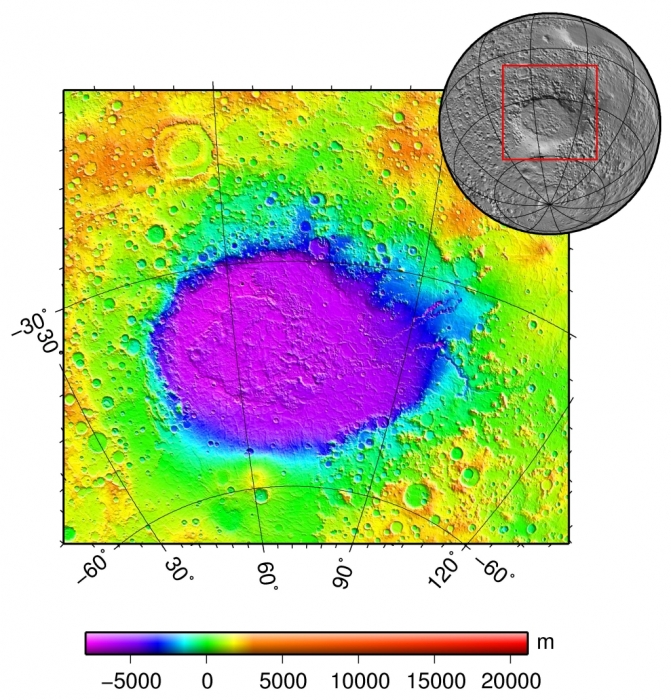Since we have considered the possibilities for worlds to support life in the Milky Way Galaxy, we should also consider the likelihood that astronomical phenomena might be responsible for ending life either on Earth or elsewhere. There are several astronomical events that may play a role in shortening the lifetime of a life-bearing planet or moon.
The first hazard we should consider is a catastrophic impact, like the one that is likely to have killed off the dinosaurs on Earth. You have already seen, for example, the impact of the comet Shoemaker-Levy 9 on Jupiter, which released large amounts of energy. We also see in several different objects in the Solar System evidence for larger scale impacts. For example, on Mars, there is the Hellas Planitia impact basin shown below.

The object that left this crater, which is more than 1,000 miles in diameter, was likely an asteroid. The force of the impact threw debris several thousand miles and left a blanket of debris approximately a mile thick over a large part of Mars' southern hemisphere.
The moon of Saturn called Mimas is significantly smaller than Mars, but also bears the mark of a major past impact, as shown below.

The impact that created this crater likely almost destroyed this moon. Given the visible evidence of massive impacts on planets and moons in the Solar System, you may ask what the probability is for an impact of this size in our future. There has been a major impact on the Earth in recorded history. Fortunately, it occurred in a relatively uninhabited region of Siberia, and it is referred to as the "Tunguska Event." Below is an image showing some of the devastation.
The exact origin of the Tunguska event is still unknown, although the evidence suggests that a meteor or comet exploded in the atmosphere before reaching Earth. There is no unambiguous crater left; however, trees for dozens of miles around the site were flattened by the explosion, which is estimated to have released energy equivalent to 15 or so megatons of TNT. Events of this size are expected statistically to occur on Earth approximately once a century. Larger impacts like the one that killed the dinosaurs are expected to occur about once every 50 million years. The largest impact on Earth since the Tunguska event was the Chelyabinsk meteor, which is estimated to have released energy equivalent to 500 kilotons of TNT in the atmosphere. To try to get some advanced warning of a potential impact, several efforts are underway to observe and catalog all of the Near Earth Objects (NEOs), that is, meteors and asteroids large enough to cause significant damage to Earth.
Want to learn more?
NASA has been charged by Congress to survey for NEOs and develop plans for diverting them from impacting the Earth. Information about the NASA program is available at the "Near Earth Object Program" website. In particular, if you have heard about the potential for a collision between Earth and Apophis in 2029 or 2036, there is a comprehensive discussion of this object there.
There is also a program called "SpaceWatch" that is independently surveying for NEOs.
NASA has received some criticism for their work preparing for the diversion of any potentially hazardous asteroids. An organization called the "B612 Foundation" is working on this independently.
The potential impact between Earth and a massive asteroid is one way in which our planet is in jeopardy from an astronomical phenomenon; but, unfortunately, it is not the only one. One of the other possibilities that we have to consider is the collision of the Earth with a molecular cloud of gas. The Earth's interaction with such a cloud is likely to destroy our atmosphere. The Earth may also lie in the path of the jet of emission from a gamma-ray burst, which will bombard the Earth with enough high energy radiation that there would again be catastrophic effects on the atmosphere. The rates of these events are also able to be estimated, and both appear to be 1 in 1 billion year type events.
